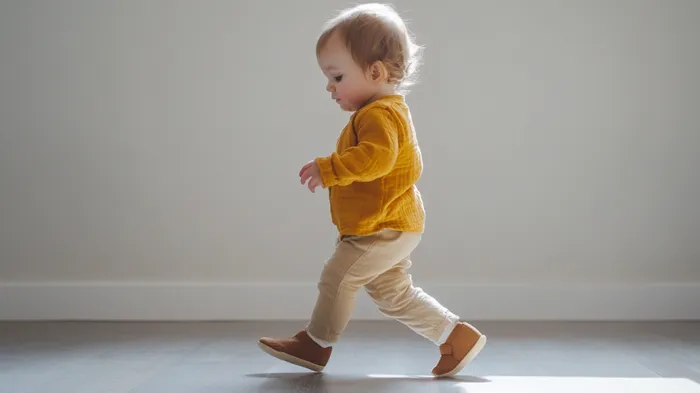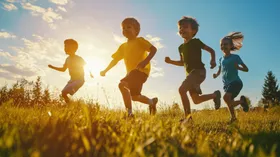Do Your Baby's Feet Point Outwards? Addressing Out-Toeing Concerns
Worried about your child's 'waddle'? Discover why out-toeing is often a normal phase and how to support your little one's development
Updated December 6, 2024.

Have you ever watched your child waddle like a duck, their little feet pointing outward? Out-toeing is a common concern among parents, leading to questions about their child's development. But don't worry! It's often a perfectly normal phase.
Let's demystify out-toeing and give you the knowledge to support your child's development
» Worried about your baby's 'waddle'? Try supportive shoes that address out-toeing
What Is Out-Toeing?
Out-toeing, also called external tibial torsion or duck feet, is a condition where feet point outward instead of straight ahead when standing or walking. It can affect one or both feet and may be more noticeable when a child starts to walk. While it might look unusual, out-toeing is generally considered a normal variation in how a child's legs and feet develop.
» Explore kids' shoes for orthotics and support your little one's foot health
Causes of Out-Toeing
There are several reasons why a child might develop out-toeing, including:
- Positioning in the Womb: A baby's position in the uterus during pregnancy can affect how its legs and feet are aligned at birth. This is often a temporary condition that resolves as the child grows.
- Genetic Factors: Some children may have a genetic predisposition to out-toeing, meaning it runs in families.
- Muscle Imbalances: In some cases, tightness or weakness in specific leg muscles can contribute to the condition.
- Developmental Variations: As children grow, their bones and joints change. Sometimes, this can result in out-toeing.
- Hip Rotation: The position of the hip joint can influence the alignment of the entire leg.
Is out-toeing the same as pigeon-toeing?
No, they're the opposite! Out-toeing involves toes pointing outward, often due to genetics, muscle imbalances, or fetal position. Pigeon toeing involves toes pointing inward, usually caused by tight calf muscles or hip joint issues.
» Discover supportive toddler sandals & sneakers for worry-free walks
How Long Does Out-Toeing Last?
In many cases, out-toeing resolves on its own as a child grows. Here's a general timeline of what you might expect:
- Infancy: Many babies are born with their feet turning outward due to their position in the womb. This often corrects itself within the first few months of life.
- Early Toddlerhood: Some out-toeing is common as children start to walk and may even help with balance.
- Preschool Years: By age 3 or 4, many children's feet will naturally align to face forward when walking.
- School-Age Years: Most cases of out-toeing are resolved by the time a child reaches school age, around 6 to 8 years old.
This timeline can vary from child to child. Some children may continue mild out-toeing into adolescence or adulthood without experiencing any problems or discomfort.
» Discover how to pick shoes for different stages of your kid's development
How Shoes Help Out-Toeing
The right footwear plays a crucial role in supporting proper foot alignment and gait development for children with out-toeing. While shoes alone cannot correct the condition, they can provide essential support and guidance during a child's formative years.
Here's what to look for:
- Heel Counter: This maintains correct foot alignment and prevents excessive outward heel movement. A firm, non-collapsible back of the shoe indicates a strong heel counter.
- Arch Support: This distributes weight evenly across the foot, improving foot placement and balance. The arch support should match your child's foot type to ensure comfort.
- Sole Flexibility: This allows for natural foot movement while providing support and grip. The shoe should flex easily at the ball of the foot to promote natural gait patterns and muscle development.
- Toe Box: A wide toe box gives toes room to spread naturally, preventing outward foot twisting. Aim for about a thumb's space width between the longest toe and the end of the shoe.
- Weight: Lightweight construction reduces fatigue and allows for more natural movement, preventing gait alterations to compensate for heavy shoes.
- Closure: A secure closure, like Velcro, helps keep the foot properly positioned within the shoe, enhancing the effectiveness of other supportive features.
» Worried about loose laces? Check out these alternatives
When to Seek Medical Attention
While out-toeing is often a normal part of development, there are times when it may warrant medical attention. Here are some signs that you should consult with your paediatrician or a pediatric orthopedist:
- Your child experiences pain or discomfort when walking or running.
- The out-toeing is severe or seems to be getting worse over time.
- Your kid has difficulty with physical activities or seems to trip frequently.
- There's a significant difference in the alignment between the left and right foot.
- Out-toeing persists beyond the age of 8 or 9 years old.
- You notice other developmental delays or concerns alongside the out-toeing.
Remember, every child develops at their own pace, and what's considered normal can vary. If you're ever in doubt about your child's development, seeking professional medical advice is always best.
» Support their first steps with shoes designed for babies learning to walk
How Duck-Toeing is Diagnosed
Here are the methods and tests your doctor may use to determine if you or your child is duck-footed:
- Medical History: Questions about the condition's duration, potential causes, and family history.
- Physical Exam: Assessing tightness, flexibility, and range of motion in legs, hips, and feet.
- Rotational Assessment: Examining angles between feet and legs, typically with the patient lying face down, knees bent.
- Gait Analysis: Observing walking patterns barefoot and in typical footwear to analyse foot placement and leg rotation.
- Developmental Evaluation: Checking overall physical development for other concerns or delays.
- Imaging Tests: If structural issues are suspected, X-rays or other scans may be ordered for a detailed view of bones and soft tissues.
» Explore the best shoes for tippy-toe walkers
Supporting Your Child's Development
While out-toeing can be concerning for parents, it is often a normal phase that children outgrow naturally. Your role in this process is not to' fix' the condition but instead to create an environment that supports overall healthy development.
Encourage your child to engage in active play to strengthen and coordinate muscles and build confidence. Ensure their feet are comfortable in well-fitting shoes with proper support. Complement this with a balanced, nutritious diet to support their growing bones and muscles.
Try to resist the urge to compare your child's progress with others, as this can lead to stress for both of you. Instead, celebrate their unique developmental path. By understanding out-toeing and providing support, you're equipping your child with the tools they need to grow confidently.
» Invest in supportive footwear to address your child's out-toeing
Disclaimer: First Walkers' information is intended for educational and informational purposes related to toddler footwear and feet. We encourage you to consider individual circumstances and consult qualified orthopaedists about specific conditions.





